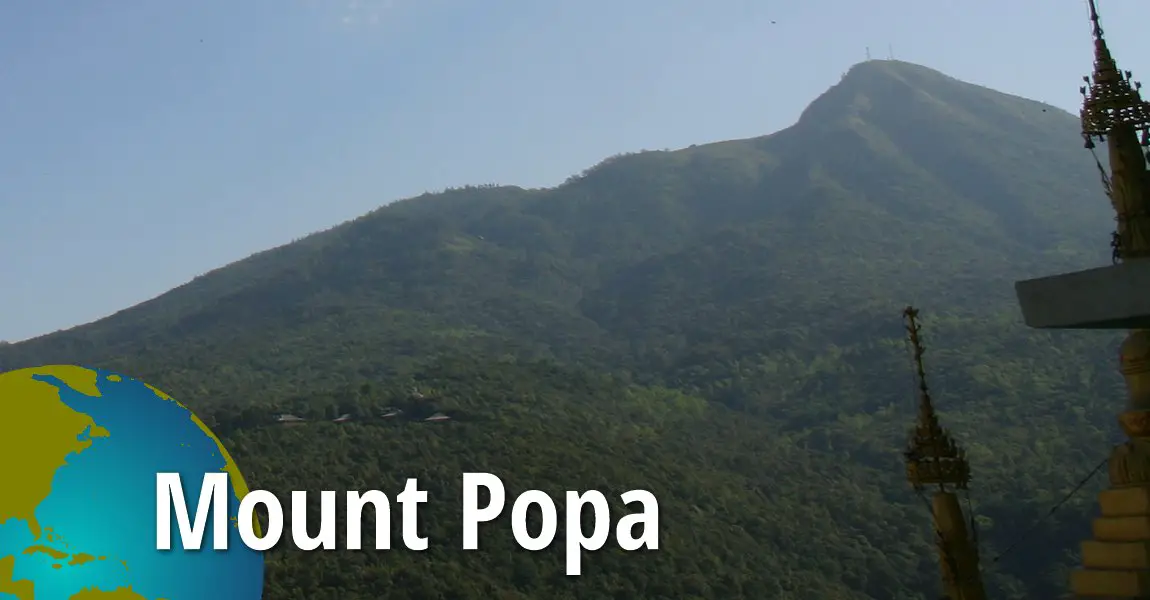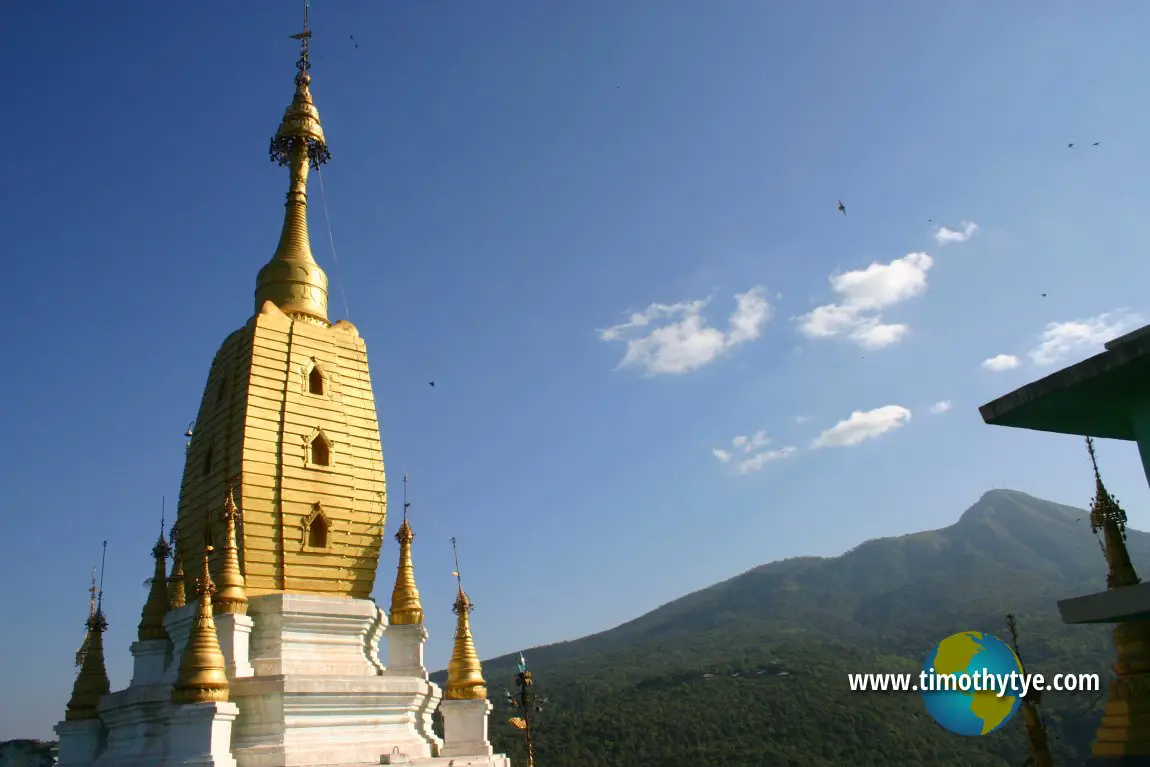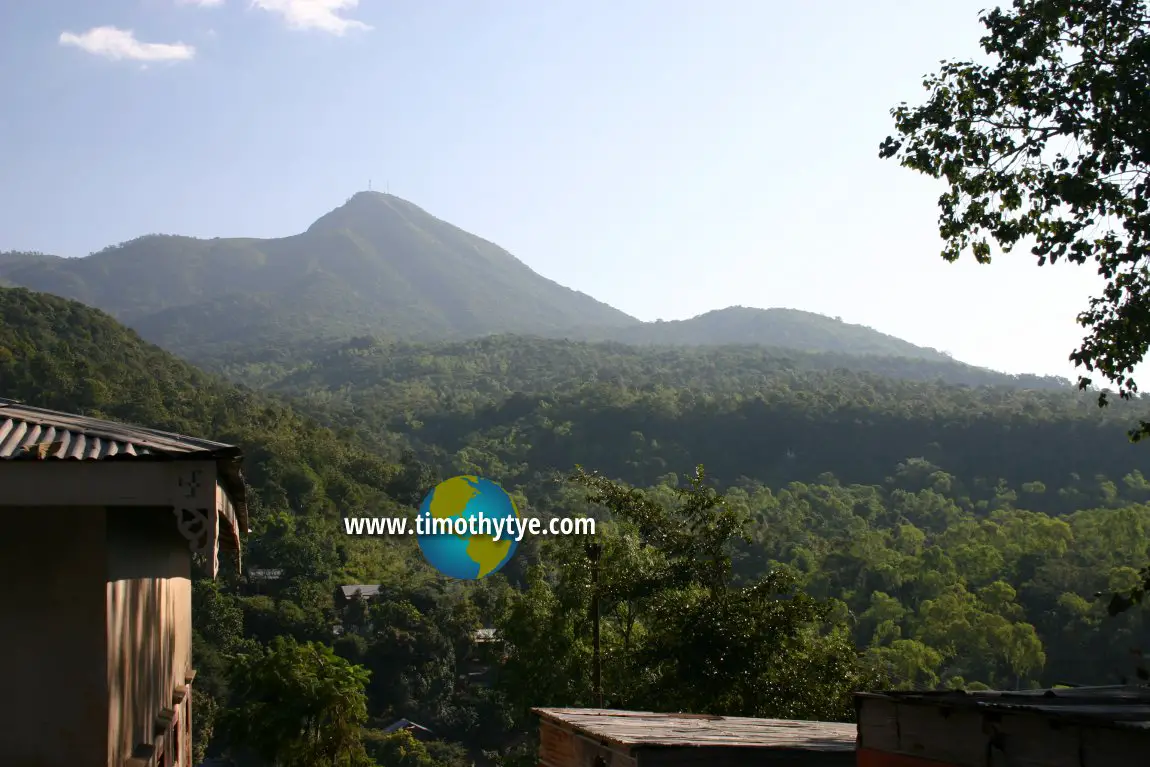 Mount Popa, as seen from Popa Taungkalat (26 November, 2003)
Mount Popa, as seen from Popa Taungkalat (26 November, 2003)
Mount Popa is a sacred mountain in Myanmar located 50km away from Bagan. It is the remnant of an extinct volcano. The name "popa" means flowers in Sanskrit, because of a local belief that the forest around Mount Popa was once home of Mai Wunna, a flower-eating ogress.
The volcano had a circular crater, but much of the northwestern rim had been blown away, suggesting that the last eruption was not vertical, but inclined towards the northwestern slope. Although from a distance Mount Popa looks like one single peak, it in fact consists of three peaks which are 4981, 4801 and 4501 feet high. Mount Popa is on a plateau that is 1000 feet above the surrounding plains, and 1800 feet above sea level. Therefore, the actual volcano is 3000 feet from the base. The area around Mount Popa is today designated a national park, and the authorities are keen to develop it for ecotourism.
The abundance of petrified fossil trees in the Bagan region suggests that the land had witnessed violent eruptions in the past, including earth movements and massive lava flows. In fact it erupted for the last time three hundred and twenty years ago.
On the southwestern slope of Mount Popa is Taung Kalat, an isolated peak that juts out of the landscape. Taung Kalat, also called Popa Taungkalat, is often confused with Mount Popa. It is 737 m (2417 ft) tall peak that some believe to be part of the main volcano was was blown apart and landed here. Another theory suggested that Popa Taungkalat is the infilled neck or plug of another smaller volcano.
Mount Popa's attraction today lies not so much in its geological past, but more in its religious and mystical attraction. Mt. Popa is regarded as the home of Myanmar's most powerful nats and as such is the most important nat worship center. Nats are local spirits which are commonly worshipped throughout Myanmar, and Mt. Popa was the Mountain of Spirits. There are many nat shrines on this mountain.
Pilgrims from all over Myanmar visit Mt. Popa every year, especially during the festival season, which are on the full moon of Nayon (May/June) and the full moon of Nadaw (November/December). This festival is known as Taunghyon (near Mandalay). Before King Anawrahta's time, thousands of animals were sacrificed to the nats during festivals. According to Burmese superstition, one should not wear red or black to Mount Popa, or to bring meat, especially pork, as it could offend the resident nats.
 Shrine on Popa Taungkalat with Mount Popa in the background. (26 November, 2003)
Shrine on Popa Taungkalat with Mount Popa in the background. (26 November, 2003)
Mount Popa Travelogue, 26-27 November, 2006
I visited Popa Taungkalat, not Mount Popa. I was curious that Henry, my tour guide, kept on saying to me that the peak in front of me was not Mount Popa, but it's Popa Club - or something. Only recently did I finally understand that he was referring to Popa Taungkalat, which sounded like Popa Club to me. View of Mount Popa from the steps going up Popa Taungkalat. (26 November, 2003)
View of Mount Popa from the steps going up Popa Taungkalat. (26 November, 2003)
 Latest updates on Penang Travel Tips
Latest updates on Penang Travel Tips
 Map of Roads in Penang
Map of Roads in Penang
Looking for information on Penang? Use this Map of Roads in Penang to zoom in on information about Penang, brought to you road by road.About this website

Dear visitor, thank you so much for reading this page. My name is Timothy Tye and my hobby is to find out about places, write about them and share the information with you on this website. I have been writing this site since 5 January 2003. Originally (from 2003 until 2009, the site was called AsiaExplorers. I changed the name to Penang Travel Tips in 2009, even though I describe more than just Penang but everywhere I go (I often need to tell people that "Penang Travel Tips" is not just information about Penang, but information written in Penang), especially places in Malaysia and Singapore, and in all the years since 2003, I have described over 20,000 places.
While I try my best to provide you information as accurate as I can get it to be, I do apologize for any errors and for outdated information which I am unaware. Nevertheless, I hope that what I have described here will be useful to you.
To get to know me better, do follow me on Facebook!
Copyright © 2003-2025 Timothy Tye. All Rights Reserved.

 Go Back
Go Back